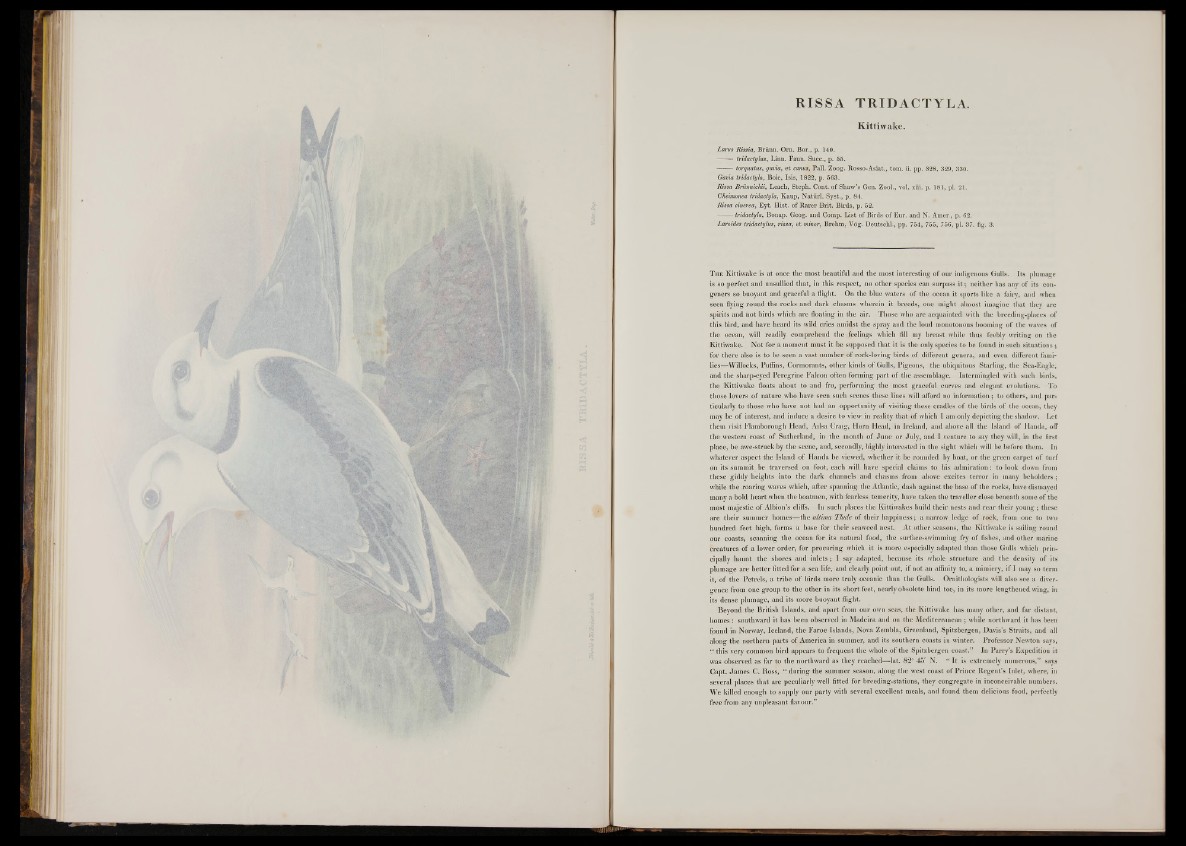
RISSA TRIDACTYL A.
Kittiwake.
Lartts Rissia, Brünn. Om-. Bor., p. 140.
tridactylus, Linn. Faun. Suec., p. 55.
(orquat-us, gavia, et canus, Pall. Zoog. Roaso-Asiat., tom. ii. pp. 328, 329, 330.
Gavia tridactyla, Boie, Isis, 1822, p. 563.
Rissa Brünnichii, Leach, Steph. Cont. of Shaw’s Gen. Zool., vol. xiii. p. 181, pl. 21.
Cheimonea tridactyla, Kaup, Natiirl. Syst., p. 84.
Rissa cinerea, Eyt. Hist, of Rarer Brit. Birds, p. 52.
— tridactyla, Bonap. Geog. and Comp. List of Birds of Eur. and N. Amer., p. 62.
Laroides tridactylus, rissa, et minor, Brehm, Yög. Deutschi., pp. 754, 755, 756, pl. 37. fig. 3.
T h e Kittiwake is at once the most beautiful and the most interesting of our indigenous Gulls. Its plumage
is so perfect and unsullied that, in this respect, no other species can surpass i t ; neither has any of its congeners
so buoyant and graceful a flight, On the blue waters o f the ocean it sports like a fairy, and when
seen flying round the rocks and dark chasms wherein it breeds, one might almost imagine that they are
spirits and not birds which are floating in the air; Those who are acquainted with the breeding-places of
this bird, and have heard its wild cries amidst the spray and the loud monotonous booming of the waves of
the ocean, will readily comprehend the feelings which fill my breast while thus feebly writing on the
Kittiwake. Not for a moment must it be supposed that it is the only species to be found in such situations;
for there also is to be seen a vast number of rock-loving birds of different genera, and even different families—
Willocks, Puffins, Cormorants, other kinds o f Gulls, Pigeons, the ubiquitous Starling, the Sea-Eagle,
and the sharp-eyed Peregrine Falcon often forming piirt of the assemblage. Intermingled with such birds,
the Kittiwake floats about to and fro, performing the most graceful.:curves and elegant evolutions. To
those lovers o f nature who have seen such scenes these lines will afford no information; to others, and particularly
to those who have not had an opportunity o f visiting these cradles of the birds o f the ocean, they
may be o f interest, and induce a desire to view in reality that of which I am only depicting the shadow. Let
them visit Flamborough Head, Ailsa Craig, Horn Head, in Ireland, and above all the Island o f Handa, off
tlie western coast o f Sutherland, in the month o f June or July, and I venture to say they will, in the first
place, be awe-struck by the scene, and, secondly, highly interested in the sight which will be before them. In
whatever aspect the Island of Handa be viewed, whether it be rounded by boat, or the green carpet o f turf
on its summit be traversed on foot, each will have special claims to his admiration: to look down from
these giddy heights into the dark channels and chasms from above excites terror in many beholders;
while the roaring waves which, after spanning the Atlantic, dash against the base of the rocks, have dismayed
many a bold heart when the boatmen, with fearless temerity, have taken the traveller close beneath some o f the
most majestic of Albion’s cliffs. In such places the Kittiwakes build their nests and rear their young ; these
are their summer homes—the ultima Thule o f their happiness; a narrow ledge of rock, from one to two
hundred feet high, forms a base for their seaweed nest. At other seasons, the Kittiwake is sailing round
our coasts, scanning the ocean for its natural food, the surface-swimming fry of fishes, and other marine
creatures o f a lower order, for procuring which it is more especially adapted than those Gulls which principally
haunt the shores and inlets; I say adapted, because its whole structure and the density of its
plumage are better fitted for a sea life, and clearly point out, if not an affinity to, a mimicry, if I may so term
it, o f the Petrels, a tribe o f birds more truly oceanic than the Gulls. Ornithologists will also see a divergence
from one group to the other in its short feet, nearly obsolete hind toe, in its more lengthened wing, in
its dense plumage, and its more buoyant flight.
Beyond.the British Islands, and apart from our own seas, the Kittiwake has many other, and far distant,
homes: southward it has been observed, in Madeira and on the Mediterranean ; while northward it has been
found in Norway, Iceland, the Faroe Islands, Nova Zembla, Greenland, Spitzbergen, Davis’s Straits, and all
along the northern parts o f America in summer, and its southern coasts in winter. Professor Newton says,
“ this very common bird appears to frequent the whole-of the Spitzbergen coast.” In Parry’s Expedition it
was observed as far to the northward as they reached—lat. 82° 45' N. “ It. is extremely numerous,” says
Gapt. James C. Ross, “ .during the summer season, along the west coast of Prince Regent’s Inlet, where, in
several places that are peculiarly well fitted for breeding-stations, they congregate in inconceivable numbers.
We killed enough to supply our party with several excellent meals, and found them delicious food, perfectly
free from any unpleasant flavour,”